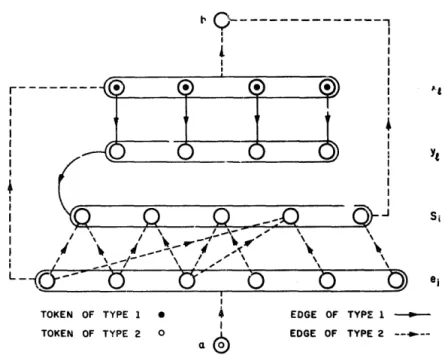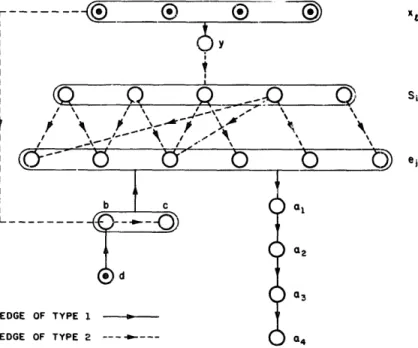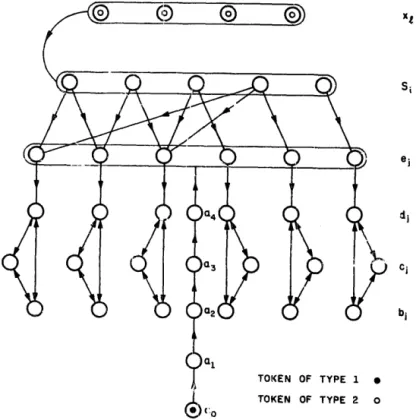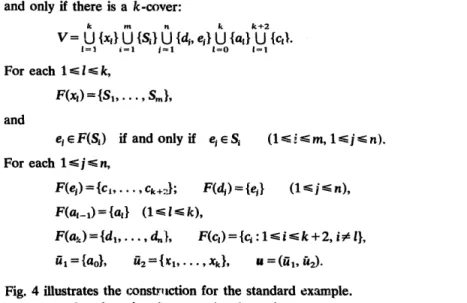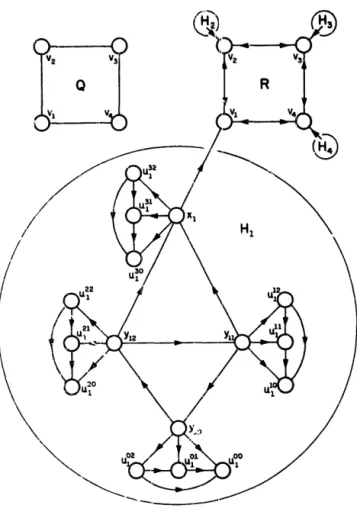Discrete Applied Mathematics 1 (1979)
@I North-Holland Publishing Company
zyxwvutsrqponmlkjihgfedcbaZYXWVUTSRQPONMLKJIHGFEDCBA
COMPLEXITY OF PlAlolsLEMS IN GAMES, GRAPHS
AND ALGEBRAJC EQUATIONS
A.S. FRAENKEL* and Y. YESHA
Dqartment of Applied Mathematics, Tilw Weizmann Znstitute of Science, Rehuvot, Zsrael WC prove NP-hardness of six families of naturally defined, interesting board games. Some of them aye “only just hard” in the sense that slight variations of them are polynomial. We further prow: NP-completeness of two problems on digraphs which are related to game strategies; and NP-completeness and NP-hardness respectively of two classical problems of abstract algebra concerning the existence of solutions of algebraic equations. Also these problems were surgested by an investigation in combinatorial game theory.
The complexities we shall be concerned with are NP-hardness and NP- completeness. Informally, the class of NP-hard problems has the iollowing important properties.
(i) There is no known polynomial-time algorithm which solves Lny single problem in the class.
(ii) The existeuce of a polynomial-time algorithm for solving any particular problem in the class implies that every NP-complete problem can be solved with a polynomial- time algorithm.
The class of NP-cbgmplete problems sitisfies (i) ar.d (ii), and, in addition, it can be solved polynomially on a nondeterministic Turing machine. It currently contains over 300 members [ 11, Appendix]. It is widely believed that no NP- complete problem can be solved with a polynomial-time algorithm, and hence that all such problems (in particular: all NP-hard problems), are inherently computationally intractable.
The formal technical requiicments for a problem to be N&hard are described e.g., in 11, Chapter 10; 11; 13, Chapter 91. For our purposes, the only require- ment is to show how a known NP-complete problem can be “transformed” in polynomial time into a problem to be proved NP-hard.
After listing some known NP-complete problems in the introduction, we prove in Section 2 NP-hardness of six families of naturally defined, interesting two- player perfect-information board games, i.e., games played by moving tokens on vertices of a digraph according to specified rules. We mention that cor;lplexities of some combinatorial games were treated previously, for example in [6, 8, 12, 141.
* Current address: Department Urbana, lL61801, USA.
16 AS.
zyxwvutsrqponmlkjihgfedcbaZYXWVUTSRQPONMLKJIHGFEDCBA
Fmenkel, Y. Yesha In Section 3 we prove NP-completeness of two problems in graph-theory whichhave some bearing on game strategies. They are the question of whether a
digraph has a (classical) Sprague-Grundy function and whether zyxwvutsrqponmlkjihgfedcbaZYXWVUTSRQPONMLKJIHGFEDCBAtheve exists a D-morphism between two digraphs. The result for the Sprague-Grundy function
is probed even for planar cyclic digraphs.
In the final Section 4 we show that a classical problem of abstmct algebra, namely the existence of solutions of a system of algebraic equations over GF(2) is
hT-complete if we ask for solutions in
zyxwvutsrqponmlkjihgfedcbaZYXWVUTSRQPONMLKJIHGFEDCBA
GF(2). I[t is further shown that the problem is ?IP-hard if we ask for solutions in the algebraic closure of GF(2).Our polynomial transformations will be made from the following four decision problems, which are kno’wn to be NP-complete.
(i) C-CQVEI? [l, 11, 131. For a given finite family of finite sets {Si}El and a positive integer k, decide whether there is a subfamily (I$}c (Si} containing at most k sets. such that lJI II1 = u:, 4. (Such a subfamily (II,} is called a k-couer.)
If there exists a k-cover, we let {h,, . . . , k,} be a set of indices such that U:=,!$,=lJEISi={e, ,..., e,}.
The polynomial transformations from the k-OVER problem will be illus- trated in the sequel by the example rk = 4, m = 5, G = 6, S1 = (e,, ed, S2 = {e,, e3}, S, = 1e3, cd, S, = {e,, e,, e5), S5 = {e,>.
(ii) 3-SATISFIAB.III’IY [l, 111. To decide whether a CNF (conjunctive normal form) Boolean formula in which each clause contains at most three literals is satisfiable.
(iii) PIAWU7 3-COLQI?A.I3lIJTY [I6]. For a given undirected planar graph 0 = (V(Q), E(Q)) (with vertex-set V(Q) and edge-set E(Q)), decide whether there is a function c : V(Q) + (0, 1,2} such that (u, u) E E(Q) 3 c(u) # c(u).
Nofatiou. By A a I3 we mean that A is polynomially transformable to B [ 11, Section 2.51.
&l digraphs I? = (V(R), E(R)) and all graphs in consain directed cycles unless otherwise specified,
F&U) = F(w) = {IJ E V(R): (u, u) E E(R)}
and
q;)(u) = F-‘(u) = (w E V(R): u E F(w)).
the sequel are finite. They may For u E V(R), let
Cumpkxity of problems 17
rules. All such games belong to the class of two-player perfect-information win- lose-tie games without chance moves discussed in [S, 7, IS]. We shall always assume (except in 2.6) that the first player unable to move is the loser: the other the winner. If there is no last move, the outcome is defined to be a tie.
A posttion y = (ir, i) in such a game consists of a subset ii c V(R) on which the tokens reside, called a eonfigumtion, and an integer i E (1,2} specifying the player whose turn it is to move from the configuration ii. The players play alternately. It is known [7, IS] that under these conditions the set of the game’s positions can be partitioned uniquely into three mutually disjoint subsets N, P and T. They have the following properties: y E N if the Next player, that is the player moving from position y, can win independently of his opponent’s moves; y E P if the Previous player, that is the opponent of the next player, can win independently of his opponent’s moves; and y E 7’ if no player can force a win from j: ~;nd therefore both can avoid losing.
The first two games considered in Section 2 are impartial, i.e., the set of configurations reachable in one move fro,m (ii, 1) and (ii, 2), coincide for all configurations ii. In this case a position is completely specified by the configura- tion, and the labels 1,2 can be disposed of. The other four games are partizan.
2.1. Annihilation
Tokens of Y different types are placed on distinct vertices of a digraph R = (V, E), whose edges are distributed into r sets El, . . . , E, (not necessarily disjoint) such that eJ :=I Ei = E. A move consists of selecting a token of type i on some u E V(R) and moving it to some u E 4(U), where, here and below, ‘we adopt the notation
If 2, is occupied by a token of any type, both tokens get annihilated and are removed from the game.
A configuration of the game is represented by a vector u = (&, . . . , I?,), where iii is the subset of vertices occupied by tokens of type i (1 C i G F), and i& n 4 = 8
(lSi<jGF).
The game is impartial. A position is therefore completely specified by the configuration. The decision problem ANNXHILATION is whether u E P for any given configuration u. We define the SIMPLIFIED-ANNIHILATION decision problem by restricting Ip to be bipartite, without directed cycles, F = 2 and
E,nE,=@
Theorem 1. k-COVER a SIMPLIFIED-ANNIHILATION. Hence SIMir’LI-
FIED-ANNIHILATION and consequently ANNIHILATION are NP-hard.
18 A S.
zyxwvutsrqponmlkjihgfedcbaZYXWVUTSRQPONMLKJIHGFEDCBA
Fracnkd. I=. Yedto zyxwvutsrqponmlkjihgfedcbaZYXWVUTSRQPONMLKJIHGFEDCBAr-
Si
“i
TOKEN OF TYPE 1 0 4 EDGE OF TYPE 1 -
I
TOKEN OF TYPE 2 0 EDGE OF TYPE 2 ---t--
Fig. 1.
zyxwvutsrqponmlkjihgfedcbaZYXWVUTSRQPONMLKJIHGFEDCBA
k-COVER a SIMPLIFIED-ANNIHILATION.E, U Ez = E, El 17 E2 = 8, and a configuration u in the annihilation game played on R, such that II E P if and only if there is a k-cover:
V= G 1% YO ij {SillCj,{eil~{a, bl9
i-1 i-1 .
WXI) = o+L FAxI) = W, f=h) = IS,, . . . , S,,,) (Mkk) ,
Si E F2(ei) if and only if ei E Si (lG:i<m, lcj<rz),
{XT,. . .,x~)E&(~,) (lsisn), &(Si)={b} (lcism),
&(a) = {e,, . . - , f-k),
&={X1v..Jk~, fi2 = W, u ‘- (61, ii&
In Fig. 1 the construction is shown for the example mentioned in the Introduction.
Edges of
zyxwvutsrqponmlkjihgfedcbaZYXWVUTSRQPONMLKJIHGFEDCBA
El are represented by solid lines, edges of E2 by dotted lines. ‘I’okens of type I are represented by solid black circles, those of type 2 by white circles. Hereand elsewhere, an arrow leadmg from (respectively toj a curve enclosing a set of vertices represents edges leading from (respectively to) each of the vertices enclosed in the set.
Complexity of problems 19 possibly on some S, by two tokens of type 1). Player 2 wins if he can force annihilation on some St or on some xl of tokens of oppudite type.
Suppose that there is a k-cover. As long as player 1 moves xl + ye player 2 builds up a cover (S,, ,, . . . , S,,,). If player 1 moves a -+ e, while some xl is still occupied, player 2 makes an annihilation move e, -+ x1. If the c.rver is completed, player 1 has to move a + e, for some 1 pi c n and player 2 can now annihilate e, --) S, for suitable 1 G i s WI.
Suppose there is no k-cover. The strategy of player 1 is to keep moving xl + y, unless either player 2 just made the move u -+ ei, in which case player 1 moves
ci + q without annihilation, or all the q become empty. In this case he moves
zyxwvutsrqponmlkjihgfedcbaZYXWVUTSRQPONMLKJIHGFEDCBA
a + e i such that Fz(ei) is unloccu,&.d.
2.2. Renrove
The rules of this impartial game are the same as the rules of annihilation, except that on impact, only the token which was moved to an occupied vertex is removed. The simplified remove game is defined analogously, and so are the decision problems REMOVE and SIMPLIFIED-REMOVE.
Theorem 2. k-COVER a SIMPLIFIED-REMOVE. Hence SIMPLIFIED-
REMOVE and consequently REMOVE are NP-hard.
Proof. The polynomial transformation uses the same construction and arguments as in the proof of Theorem 1.
2.3. Contrajunctive
A digraph R = (V, E) is given, together with subsets El, E2 of E (not necessar- ily disjoint) such that El L.I E2 = E. Tokens of one type are placed on distinct vertices of R. A move of player 1 in this game consists of moving a token from
some vertex u to some v EF#(u) (i
zyxwvutsrqponmlkjihgfedcbaZYXWVUTSRQPONMLKJIHGFEDCBA
~{1,2]). If v is occupied, both tokens get annihilated and are removed from the game. A configuration of the game is givenby E c V, where ii is the set of vertices on which tokens reside.
The game is par&an when El #ET. The decision problem CONTRAJUNC- TIVE is whether (u’, i) E P for any given position (w’, i) (i E { 1,2)). The SIMPLIFIED-CONTRAJUN~ decision problem is defined by restricting R to be without directed cycles and El n E, = (3.
Theorem 3. k-COVER a SIMPLIFIED-CONTRAKJNCTIVE. Hence SIMPLI-
FIED-CONTRAJUNC and consequerttly CON’HWJUNCI’IVE are Np-
hard.
20 A.S. Fwenkcl, Y. Yesha
E, U Ez = E, E, n E2 = f& and a position (fi, 1) in the contrajunctive game played cn R, such that (ii, 1)~ P if and only if there is a k-cover:
Vz
6
{XI)
6
{&I
6
{eil
6
{al)U {b, C, d, y},I=1
zyxwvutsrqponmlkjihgfedcbaZYXWVUTSRQPONMLKJIHGFEDCBA
i=l j=l I=1F,(xh=W,
FAxI)=Ud
(l=+W, f%(Y) =@I, - - * ,
S”,),
ei E F2(i . , if and only if ej E Si
zyxwvutsrqponmlkjihgfedcbaZYXWVUTSRQPONMLKJIHGFEDCBA
(lGi?rl, lqGn),F,(e;‘ - ’ 1, (1 q<?ln), Fr(al-r)=(q) (l<Iskh
F,(d)= !E 6(b) = w, M b) = F,(c) = h . . . , en),
6 = {d, x:,, . . , xk}.
Fig. 2 illustrates the construction for the example given in the Imroduction. Suppose that .here is a k-cover. As long as player 1 moves x1 + y, player 2 builds up a co .dr j&,, . . . , S,,). If, while there exists an occupied xl, player 1 moves d + b, plJyzr 2 annihilates x1 -=+ b, thus guaranteeing a win. Otherwise, player 1 is forced to move d + b after the cover was completed. Then player 2 moves b - - * c and player 1 is forced to move c + ei for some 1 <a’ GIZ. There exists 1 s I s k such that ei E F(S,,). Hence player 2 can annihilate S,,, + ei and win.
r --- . I
I I
I Q-=7?2
I I
EDGE OF TYPE I. --
EDGE OF TYPE 2 ----c---
6 a4
zyxwvutsrqponmlkjihgfedcbaZYXWVUTSRQPONMLKJIHGFEDCBA
Si
Complexity of problems 21
Now suppose that there is no k-cover. Then player I moves x1 --* y. As long as player 2 moves y -+ S* or St + e, for some 16 i d m, 1 si s n. player 1 keeps moving x[ -+ y. There are two possibilities:
(i) The indicated play continues until player 1 moves xk --, y and all the xl
(1 c
zyxwvutsrqponmlkjihgfedcbaZYXWVUTSRQPONMLKJIHGFEDCBA
1 d k) are unoccupied. Player l’s next move is d + b. Since there is no k-cover, there exists some unoccupied q such that also G’(q) is unoccupied.Player l’s next move is b (or c) + e,, and his next move is ei --, Q,. Since player 2 has now ali most k - 1 tokens on S, and hence only at most 9c - 1 additional moves and it is his turn to move, player 1 can win.
(ii) Player 2 breaks the indicated pattern of play by mving xi 3 b. Then player 1 moves b + e,, where ej is chosen as in (i). Player l’s next move is ag& ej + (IZ~. Player 1 will now move a1 + a2 only when he has no other move, that is when
b, c, d and all the xi are unoccupied, leading to a win of player 1.
Note. The special case El = E2 = E of CONTRAJUNCRWZ is the contrajunctiue compound annihilation game, which is impartial. This special case is aiso the case r = 1 of ANNIHILATION (Section 2.1 above). The contrajunctive compound annihilation game has a rather intricate, but polynomial strategy [9]. Thus it appears that all these games are close to the borderline between polynomial and NP-hard games-if such a borderline exists.
2.4. Capture
Tokens of types 1 and 2 are placed on distinct vertices of a given digraph R = (V, E). A move of player 1 in this (pa&an) game consists of moving a token of type i (i E (1,2)) from some IA E V to some o E F(u) which is not occupied by a token of the same type. If u is occupied by a token of the opposite type, the latter (only) is “captured” and removed from the game.
A configuration in the game is given by u = (&, a,), where ii1 and i& are disjoint subsets of V(R), namely, i& is the subset of vertices on which there are tokens of type i. A position is then given by (u, i) (i E (1,2}). The decision problem CAPTURE is whether (u, i) E P for any given position (u, i) (i E { 1,2}).
meorem 4. k-COVER ~CAPTURE. Hence CAPTURE is M?-hurd.
Proof. Given an instance of the k-COVER problem, we construct a digraph
22 AS. Fraertkel, Y. Yesha and
ei E S;(S) if and only if ei E Si (l=Gint, lqQ&),
F(e,) = {d,)* F(4) = .(bi, cj),
Hc;) = 1q9 dj)9 F( bj) =
zyxwvutsrqponmlkjihgfedcbaZYXWVUTSRQPONMLKJIHGFEDCBA
(Cj, ti\} (1 qwln),F(a,_,)=(u,} (lslek), Ha,) = {e,, . . . 9enh
u,={a,~, fiZ={Xl,....Xk}, u = (ii,, ii*).
Fig. 3 illustrates the construction for the example in the Introduction.
Suppose that there is a k-cover. As player 1 moves q-r --, q, player 2 moves xl - S,,, (1 G Is k), building up a cover (S,,,, . . . , S,,). After 2k moves, the configuration ((a,), (S,, . . s , S,,,)) is reached. Player 1 is LOW forced to move (z~ - ei for some 1 Si G n. Yhere exists 1 G 1 G k such that ej E F(S,,,). Player 2 moves S,,, - ei, capturing the token of type 1 and winning.
TOKEN OF TYPE 1 o
TOKEN OF TYPE 2 0
Complexityof problems
zyxwvutsrqponmlkjihgfedcbaZYXWVUTSRQPONMLKJIHGFEDCBA
23Conversely, suppose that there is no /c-cover. After 2k moves, when ii1 = (a,), there exists 1 s j < n such that b,, c,, d,, e,, .F’(e,) are all unoccupied. Then player 1 moves uk + e,. He can avoid losing by moving to di and then plying between b, and c,.
Note. Theorem 4 implies, in particular, that the game “On The Line” marketed by Skye Marketing Corp. in the U.S.A. and by Orda Inc. in Israel (under the name “Arrows”), is NP-hard when played on a general digraph.
2.5. BZocking
Tokens of types 1 and 2 are placed on distinct vertices of a digraph R = (V, E).
A move of player 1 consists of moving a token of type i from some u E
zyxwvutsrqponmlkjihgfedcbaZYXWVUTSRQPONMLKJIHGFEDCBA
V(R) to some unoccupied u E F(u). A configuration in this (par&an) game is given byu = (i&, I&), where fi, designates the subset of V(R) on which tokens of type i
reside and ii1 n i& = 9. Th e d e&ion problem BLOCKING is whether (M, i) E P for
any given position (18, i) (i E { 1,2)).
zyxwvutsrqponmlkjihgfedcbaZYXWVUTSRQPONMLKJIHGFEDCBA
Theorem 5. k-COQER a BLOCKING. Hence the latter is IW-hard.
Proof. Given an instance of the k-COVER problem, we construct 2, digraph R = (V, E) and a position (a, I) in the blocking game on R, such that (u, 1) E P if and only if there is a k-cover:
V=l~~{x,}iq,,,i~~~~, e,),tJoh(i@J.
For each lsZ<k,
R(x,) =I&, * - -, SiJ,
and
ei E F(S) if and only if ej E Si (lc%m, lsjia).
For each lsjsn,
F(ej) =h . . . ,
ck+:!k F(dj)=tejl
(IsiGn),F(a&={a,} (l<IIk),
R(& = {d,, . . l ,&,‘I, F(q)={q:l~i<k+2,i#I},
Fig. 4 illustrates the construction for the standard example.
24 A.S. Fraenkel, Y. Yesha
zyxwvutsrqponmlkjihgfedcbaZYXWVUTSRQPONMLKJIHGFEDCBA
r
zyxwvutsrqponmlkjihgfedcbaZYXWVUTSRQPONMLKJIHGFEDCBA
TOKEN OF TYPE 1 0
a2 TOKEN OF TYPE 2 0
‘ %
“ 0
Fig. 4. k-COVER~BLOCKING.
Conversely. suppose that there is no k-cover. By an argument used previously, player 1 can now move to some ei. Fram there he moves to some q, thut forcing a tie.
2.6.
zyxwvutsrqponmlkjihgfedcbaZYXWVUTSRQPONMLKJIHGFEDCBA
TargetThis game has the same rules as blocking, but in addition subsets T,, T2 c V are specified. Whenever all tokens of type i are placed on vertices of Ti_ the game stops and playlrr i is declared the winner (i E {(l, 2)). If no player attains this goal, the usual win-lose-tie convention applies.
The special case zyxwvutsrqponmlkjihgfedcbaZYXWVUTSRQPONMLKJIHGFEDCBAT2 = 0 of target is called kSYMM5T.C TARGET. The game
zyxwvutsrqponmlkjihgfedcbaZYXWVUTSRQPONMLKJIHGFEDCBA
SIMPZ JHED ASYIMMET RIC T ARGET is obtained by the further re-quirements: R is bipartite and without directen circuits. As usual, a configuration in any of these games is given by u -= (ir ,, i&), and the decision problems
TARGET, ASYMMETRIC-TARGET, SIM-PLIFIED-ASYMMETRIC-
TARGET are whether (u, i)E P (3 E {I, 2)). The polynomial transformations
BLOCKING L:. ASY.MMETRIC-TARGET 0~ TARGET are immediate, and
Complexity of ptvbfems 25
zyxwvutsrqponmlkjihgfedcbaZYXWVUTSRQPONMLKJIHGFEDCBA
Theorem 6. zyxwvutsrqponmlkjihgfedcbaZYXWVUTSRQPONMLKJIHGFEDCBAk-COVEIt a SIMPLIFIED-ASYMMEiTRIC-TARGET. Herxe the fatter is NP-hard.
Pro&. Given an instance of the k-COVER problem, we construct a bipartite digraph I? without directed cycles as in the proof of Theorem 5, but omitting the vertices Cl, . . . , i:k+2. we let Tl = (q, . . . , e,,}, il = {ao}, & = {xl, . . . , xk), U = (iii, ii2). The proof that (u, 1) E P if and only if there is a k-cover is very similar to lthe proof of Theorem 5, and therefore we omit the details.
3. NP complete problems concerning dfgrapbs
3.1. Planar Grundy
Let .T” denote the set of nonnegative integers. If S is any set of integers, let mex S = smallest member of .I” not in S. If pi = (V, E) is any digraph, a (classical) Sprague-Grundy function g: V+ J() is defined by g(u) =mex (g(F(u))) for all IA E V [3, Chapters 3-6; 5, Chapter 111. Since g(u) is clearly bounded above by the maximal out-degree of u, the decision problem GRUNDY whether pi has a (classical) Sprague-Grundy function is in JK!?. We prove that even the prob!em PLANAR-GRUNDY-when I? is restricted $0 a planar digraph-is NP- complete.
Theorem 7. PLANAR 3-COLORABILlTY a PLANAR-GRUNDY. Hence the latter is NP-complete.
Proof. Given an undirected planar graph Q = (V(Q), E(Q)) with V(Q) = b 1, . . . , v,,,), we cons&& a planar digraph R == (V(R), E(R)) such that Q is 3-colorable if and only if R has a (classical) Sprague-Grundy function:
V(R)=
zyxwvutsrqponmlkjihgfedcbaZYXWVUTSRQPONMLKJIHGFEDCBA
V(Q)
6
V(H,)v
i=l
where the graphs Hi are all isomorphic (1~ i c m):
v(H,)={%i)U{YKJ9 Yil9
zyxwvutsrqponmlkjihgfedcbaZYXWVUTSRQPONMLKJIHGFEDCBA
Yi2) ir I? iUi”l*i=O k=O
F(uiO) = Q. F(u!;‘) = {uio), F(u~2) = (ui”, ui “) (0+=3);
F(q) = (Ui, Uf”, U”‘, Id:‘}, HYiO ) = (Yi29 Up09 UO ’, U02}9
F(Yil) ={&a YiO , Uf', Utl, Uf2}, F(Yi2)={&9 yil, Uf”9 UF’9 U:‘},
and
F(Z+)={WE V(Q): (t+ui, w)EE(Q )} (l<i<m).
26 A.S. Fraenlcel, i’. Yesha
Fig. 5. PLANAR 3-COLORABILITY a PLANAR-GRUNDY.
Suppose that Q has a coloration c with the colors
zyxwvutsrqponmlkjihgfedcbaZYXWVUTSRQPONMLKJIHGFEDCBA
0,zyxwvutsrqponmlkjihgfedcbaZYXWVUTSRQPONMLKJIHGFEDCBA
1,2. Define an induced coPor%g c’ as fo!lows: For all v EzyxwvutsrqponmlkjihgfedcbaZYXWVUTSRQPONMLKJIHGFEDCBA
V(Q) for which c(v) = 0, put c’(u) = 0. For everyc E V(Q) with c(u) = 1 such that c’(w) # 0 for all w satisfying (u, w) F- E(Q), put c’(u) = C; otherwise c’(u) = c(u) = 1. Similarly, for every ZI E V(Q) with c(u) = 2 such that c’(w) # 0 for all w satisfying (u, w) E E(Q), put c’(u) = 0; otherwise, if c’(w) # 1 for all w satisfying (t), w) E E(Q), put c’(u) = 1; otherwise c’(u) = c(v) = 2.7%~ cc is also a coloration of Q, with at most 3 colors, and iwith the additional property c’(rI) - - mex (c’(w) : (a, w) E E(Q)} for all u E V(Q). Hence a (classical) Sprague-Grundy function on R is given by g(u) = c’(u) for all I.I E V(Q); g(q) = 3,
COt?tPb btY Of problems 27
Conversely, suppose that R has a (classical) Sprague-Grundy function g. It
evidently su@lces to show that g(q) = 3 for all 1 =~i d m,
zyxwvutsrqponmlkjihgfedcbaZYXWVUTSRQPONMLKJIHGFEDCBA
because this implies g(t+)E(O, 1,2) for all q E V(Q), and so c(q)= g(q) (1sii.m) is a coloration ofQ with at most three colors.
We have g(&)a3 (laicm), because g(@)=k (lsism, O<j~3,O~k<2).
zyxwvutsrqponmlkjihgfedcbaZYXWVUTSRQPONMLKJIHGFEDCBA
SU PPOSE that g(xi)>3 for some 1 pi G HI. Also g(y&>3. N OW
g’tYi0)=3* g(Yi1)>3* g(Yi*)=35 gtYiO)>39
a contradiction. Similarly,
g(yi0)‘3 3 g(Yil)=3 3 dYi2)>3 rS gtYid= 39
a contradiction. Hence g(q) = 3 for all 1 &i sm.
Note. The NP-completeness of KERNEL (whether a digraph has a kernel) and GRUNIX’ was announced in [lo], together with some of the other results of this paper. In the meantime M.R. Garey and D.S. Johnson informed us that KER- NEL and GRUNDY were proven independently by Chvatal[4] and van Leeuwen [18] respectively. Therefore we omitted KERNEL. But we did not hear of anybody having done PLANAR-GRUNDY before.
3.2. D-morphism
Let R = (V(R), E(R)), d = (V(R), E(R)) be digraphs. A mapping A : V(R) 3
V(E) is called a D-morphism if
F,a,(Uu)) = W(,,(u)) c ~,&(~9 LJ F&h(u)) 0)
for every u E V(R). It is known that D-morphisms preserve strategies for game- graphs without directed circuits [2]. Given digraphs R, I!& the decision problem
D-MOR.PH.ISM is whether there exists a mapping A : V(R) + V(R) satisfying
(1). This problem is clearly in Ng.
Theorem 8. PLANAR-GRUNDY ED-MORPHISM. Hence the latter is NP-
complete.
Proof. Given a planar digraph R, we construct a digraph R =
(V(E), E(R)), V(R) = (0,. . . , d), where
d=max{IF(u)l: UEV(R)} and E@)=:{(i,j): Osj<i<d}.
Clearly E has a (classical) Sprague-Grundy function defined by g(i) = i
(OQisd).
28 A .S. Fraerxkel, Y. Yesha
the definition of k, there exists u’tz F&A(u)) such that g(u’) = i. By the left-
hand-side of (I), there exists u (1 F&U) such that h(u) = u’. Thus g(z)) =
zyxwvutsrqponmlkjihgfedcbaZYXWVUTSRQPONMLKJIHGFEDCBA
g@(u)) = g(u’)= i. §uppose there exists u E&(U) satisfying g(u)= g(u). Then A(u)=h(u).By the right-hand-side of (I),
A(u) = A(u) E F&A(II))
zyxwvutsrqponmlkjihgfedcbaZYXWVUTSRQPONMLKJIHGFEDCBA
U F&A(u)),a contradiction to the dlefinition of g on R.
Conversely, suppose that g is a (classical) Sprague-Grundy function on R.
Define the mapping
zyxwvutsrqponmlkjihgfedcbaZYXWVUTSRQPONMLKJIHGFEDCBA
A :: V(R) 4 V(R) by A(u)= g(u). Let u’eF&(u)). Then u’< A(u) = g(u). Hence ttlere exists u E F&U) satisfying A(u) = g(u) = u’, estab-lishing the left-hand-side of (1). Now let 11 E&,(U). Then A(u) = g(u) and g(u) # g(u), hence A(u) f A(u). If A(u)CA(u), then A(u)~F~~,(h(u)). If A(u)> h(u), then A(u)E E;$(A(u1), establishing the right-hand-side of (1).
4. zyxwvutsrqponmlkjihgfedcbaZYXWVUTSRQPONMLKJIHGFEDCBASohab-ility of dgebraic equations
4.1. Equutiom
Given a system S = [Pi(X,, . . . , x,,)}:, of m polynomials in q, . . . , x, with coefficients in c;%‘(2), let
MS1 ={h * - . ,
&)EGF(2)“: Pi(tLl, * * *) p,)=O (l~iim)},where C%(2)” is the n-fold Cartesian product of GF(2). The decision problem EQUATIONS whether MS] # fl is clearly in JVY.
Tbewem 10. 3-SATISFIABILITY aEQUATIONS. Hence the latter is NP-
rompiere.
Proof. Let 0(x,, . . . , &)I be a CNF Boolean formula, which is a conjunction of the clauses C1, . . . , C,,,, wl:ere each clause contains at most three literals. For each C, we construct a polynomial Qi over GF(2) by application of the transformations
Z=l&C, AvR=A@B@A.B
for all Boolean variables x and all Boolean formulas A, B (where @ and l are
addition and multiplication respectively over GF(2)), and by expanding and collecting terms. For example, the clause x1 vx2v R3 transforms into
I,:+%,@& ’ X2)@(X3@1)@(X&3X&3X1 ’ X2) l (X3@))=
=X 1 * x2 l XX@)xl * X3cBX2 * x,cBx,G31.
Finally, we let m?, = 1@0i (lsiim), S=(Pijzra Clearly
c,(P1, * -. , Pd = 1 - N/h - . * , CL,) = 0
Complexity of r soblems 29 Thus 0 is satisfiable if and only if ikf[S] # 0. The length of each Pi is bounded by O (log n), since each Ci contains only three variables.
4.2. Variety
Given a system S =(&(x1, . a . , JL.,,)));“=~ of m polynomials with coefficients in GF(2), let nS] be the set of all vectors (jeI, . . . , p,,j in the algebraic closure of GF(2), such that Pi,(pl,. . . , cc,) = 0 (1s i S m). We consider the decision problem VARIETY whether VS] # 0.
Theorem 11. EQUATIONS a VARIETY. Hence the latter is hT-ha&.
Proof. Given S’= (R’,, . . . , PI,} for the EQUATIONS problem, let Pi =P’i
(lsiem), Pm+i =$Y13xi (lsisn). Let S=(PI,...,P,+,}. Then vs]#0e
rw[S’l
f: 1.
Notes. (i) VARIETY is decidable. See [P7, Ch. ,XI].
(ii) M.R. Garey and D.S. Johnson informed us that EQUATIONS was done independently by L.G. Valiant who even made the equations quadratic.
References
[l] A.V. Aho, J.E. Hopcroft and J.D. Ulhnan, The Design and Analysis of Computer Algorithms (Addison-Wesley, Reading, Ma, 1974).
[2] R.B. Banerji, Shnilarities in games and their use in strategy construction, Proc. Symposium on Computers and Automata (Polytechnic Press, Brooklyn, NY, 1971) 337-357.
[3] C. Berge, The Theory of Graphs and its Applications, translated by A. Doig (Wiley, New York, 1962).
[4] V. Chwltal, Gn the computational complexity of finding a kernel, Report No. CRM-300, Centre de Recherches Mathkmatiques, Universite de Mont&al, 1973.
[5] J.H. Conway, Gn Numbers and Games (Academic Press, London, 1976).
[6] S. Even and R.E. Tarjan, A combinatorial problem which is complete in polynomial space, Seventh Annual ACM Symposium on Theory of Computing (Albuquerque, NM, 1975) (Assoc. Comput. Mach., New York, 1975) 66-71.
[7] A.S. Fraenkel, From Nim to Go, Proc. Symp. on Combinatorial Math. and Optimal Design, Colorado State University, Fort Collins, June 1978. To appear.
[S] A.S. Fraenkel, M.R. Garey, D.S. Johnson, T. Schaefer and Y. Yesha, The complexity of checkers
on an N
zyxwvutsrqponmlkjihgfedcbaZYXWVUTSRQPONMLKJIHGFEDCBA
X N board-preliminary report, Proc. 19th Annual Symp. on Foundations of ComputerScience (Ann Arbor, MI, Oct. 1978) (IEEE Computer Sot., Long Beach, CA, 1978) 55-64 [9] A.S. Fraenkel and Y. Yesha, Theory of annihilation games, Bull. Amer. Math. Sot. 82 (1976)
775-777.
[la] A.S. Fraenkel and Y. Yesha, Some NP-hard problems in combinatorial games and graph theory, Abstract, Notices Amer. Sot. 24 (1977) A-33.
[ll] M.R. Garey and D.S. Johnson, Computers and Intractability: A Guide to the Theory of NP-Completeness (W.H. Freeman, San Francisco, 1979).
30 A.S. Fraenkel. Y. Yesha
[I33 E.M. Reingold. J. Nievsrgelt and N. Deo, Combinatorial Algorithms: Theory and Practice (Prentice Hall, Englewood Cliffs. NJ, 1977).
:14] T J Schaefer, Complexity of decision problems based on finite two-person perfect-information
games, Eighth Annual ACM Symposium on Theory of Computing (Hershey, Pa, 1976)
(Assoc. Comput. Mach., New York, 19761 41-49.
[151 C.A.B. Smith, Graphs and composite games, J. Combinatorial Theory 1 (1966) 51-81. [163 L. Stockmeyer, Planar 3-colorability is polynomial complete. SIGACI News 5 (1973) 19-Z. Cl7j B.L. van der Wacrden, Modern Algebra, Vol. II (Fredrick Ungar, New York, 1950). El81 J. van Leeuwen. Having a Grundy-numbering is NP-complete, Report No. 207, Computer
